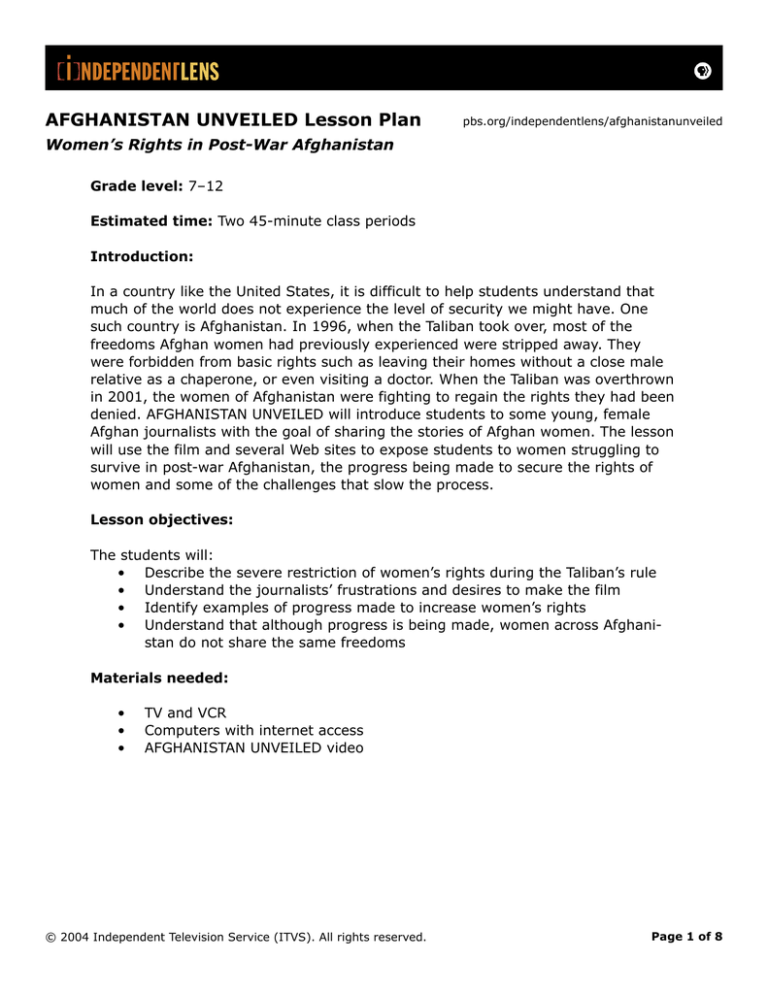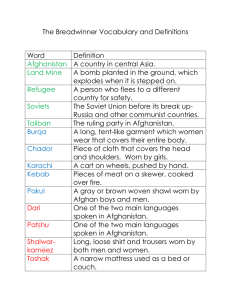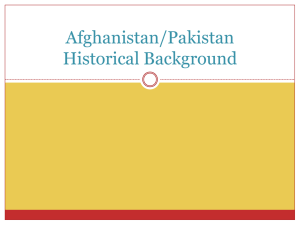
AFGHANISTAN UNVEILED Lesson Plan
pbs.org/independentlens/afghanistanunveiled
Women’s Rights in Post-War Afghanistan
Grade level: 7–12
Estimated time: Two 45-minute class periods
Introduction:
In a country like the United States, it is difficult to help students understand that
much of the world does not experience the level of security we might have. One
such country is Afghanistan. In 1996, when the Taliban took over, most of the
freedoms Afghan women had previously experienced were stripped away. They
were forbidden from basic rights such as leaving their homes without a close male
relative as a chaperone, or even visiting a doctor. When the Taliban was overthrown
in 2001, the women of Afghanistan were fighting to regain the rights they had been
denied. AFGHANISTAN UNVEILED will introduce students to some young, female
Afghan journalists with the goal of sharing the stories of Afghan women. The lesson
will use the film and several Web sites to expose students to women struggling to
survive in post-war Afghanistan, the progress being made to secure the rights of
women and some of the challenges that slow the process.
Lesson objectives:
The students will:
• Describe the severe restriction of women’s rights during the Taliban’s rule
• Understand the journalists’ frustrations and desires to make the film
• Identify examples of progress made to increase women’s rights
• Understand that although progress is being made, women across Afghanistan do not share the same freedoms
Materials needed:
•
•
•
TV and VCR
Computers with internet access
AFGHANISTAN UNVEILED video
© 2004 Independent Television Service (ITVS). All rights reserved.
Page 1 of 8
AFGHANISTAN UNVEILED Lesson Plan
pbs.org/independentlens/afghanistanunveiled
Women’s Rights in Post-War Afghanistan
Standards:
National Standards for History
http://www.sscnet.ucla.edu/nchs/standards/worldera9.html
The student understands how liberal democracy, market economies and human
rights movements have reshaped political and social life. Analyze how feminist
movements and social conditions have affected the lives of women in different
parts of the world and compare women’s progress toward social equality, economic
opportunity and political rights in various countries. (Draw comparisons across
regions.)
National Council of Teachers of English
http://www.ncte.org/about/over/standards/110846.htm
Standard 7: Students conduct research on issues and interests by generating ideas
and questions, and by posing problems. They gather, evaluate, and synthesize
data from a variety of sources (e.g., print and non-print texts, artifacts, people) to
communicate their discoveries in ways that suit their purpose and audience.
Standard 9: Students develop an understanding of and respect for diversity in
language use, patterns and dialects across cultures, ethnic groups, geographic
regions, and social roles.
© 2004 Independent Television Service (ITVS). All rights reserved.
Page 2 of 8
AFGHANISTAN UNVEILED Lesson Plan
pbs.org/independentlens/afghanistanunveiled
Women’s Rights in Post-War Afghanistan
Teaching Strategy:
1. As students begin to learn more about the rights of women in post-war
Afghanistan, it is helpful for them to have an understanding of the religion and
beliefs that guide the personal and political decisions of the Afghan people. Ensure
students are familiar with basic history, terms, concepts and geography of the
region. Begin by reviewing some common terms of Islam and beliefs of Muslims.
If there are Muslim children in the class, elicit their help to explain some of these
terms and concepts. Resources for this activity are the following Web sites from the
PBS / Frontline “Muslims” Teachers Guide:
Beliefs and Daily Lives of Muslims
http://www.pbs.org/wgbh/pages/frontline/teach/muslims/beliefs.html
Glossary of Terms
http://www.pbs.org/wgbh/pages/frontline/teach/muslims/glossary.html
Create a worksheet for students to use individually or in small groups.
Ask students to define the terms and answer the questions.
Terms: Allah, Arab, Hijab, Islam, Mosque, Muslim, Quran
Questions:
• Ask students to respond to the following questions:
• What is the difference between an Arab and a Muslim?
• What is Ramadan?
• What are the basic guidelines in a Muslim’s daily life? What are they encouraged to do and to avoid?
• Read the section in the Daily Lives of Muslims about Role of Women in
Islam. Is there anything listed in that section that is different from what
you’ve heard or previously believed?
Discuss the terms and concepts with students spending additional time on those
areas where students may need further explanation. After you feel like students
have an understanding of the basic terms and concepts of Islam, begin to focus the
class of the country of Afghanistan.
© 2004 Independent Television Service (ITVS). All rights reserved.
Page 3 of 8
AFGHANISTAN UNVEILED Lesson Plan
pbs.org/independentlens/afghanistanunveiled
Women’s Rights in Post-War Afghanistan
2. How have the lives of women changed in post-war Afghanistan? Pose this
question to students. Ask students to brainstorm what they think of when they
think of Afghan women. Students will most likely identify images they have seen
through the news of women wearing burqas, war, poverty, possibly trying to vote.
Remind students that since 2001—when the Taliban was overthrown—the country
has been rebuilding and moving toward a democracy and equality for Afghan
women.
While the Taliban was in power, women were stripped of most of their basic rights.
They could not work outside of their homes, travel without male chaperones, be
seen by male doctors, or go to school. They were also required to wear burqas
in public, the full body veil that even covered their faces. Since that time, things
have started to change. Women are beginning to regain their rights. The number of
women/girls in school has increased, many of the restrictions have been removed,
and the constitution requires female representation from the provinces and states
that “the citizens of Afghanistan— whether man or woman—have equal rights and
duties before the law.” What does this mean, though? How have the lives of women
changed? Look at a few segments of a film created by young Afghan women and
hear what they have to say about their past and the challenges they continue to
face.
3. Cue the AFGHANISTAN UNVEILED video to 25:44, the second segment
highlighting Jamila Emami and her travels to Jalalabad. You will see Jamila in a blue
outfit wearing a black headscarf walking through a door. While watching this clip,
ask students what Jamila has to do prior to traveling to Jalalabad. PLAY the film and
PAUSE at 26:03 when Jamila says, “This is a great opportunity for us to overcome
this oppression by using our cameras.” Then pause to discuss.
Discuss Jamila’s father. What was his reasoning for allowing Jamila to take this
journey? What does he believe his role is as a leader in his society? How does
Jamila feel about being allowed to travel?
Jamila takes this journey to Jalalabad and beyond, visiting locations they had
not planned. Instruct the students to watch the next segment and contrast the
freedoms Jamila has as compared to the women she visits.
PLAY until you see the two journalists on the river as they begin their return to
Kabul then PAUSE the tape at 34:57. Ask students how Jamila and her companions
felt at the end of this trip. How have they been inspired? What did they see? What
did they learn? Was their experience what they expected? What is meant by Jamila
stating, “We can never again plead ignorance”?
© 2004 Independent Television Service (ITVS). All rights reserved.
Page 4 of 8
AFGHANISTAN UNVEILED Lesson Plan
pbs.org/independentlens/afghanistanunveiled
Women’s Rights in Post-War Afghanistan
4. Provide students with the opportunity to learn more about the history of
Afghanistan. Ask them to log onto the AFGHANISTAN UNVEILED Web site. Look at:
Women in Afghanistan: Afghan Women’s Rights
http://www.pbs.org/independentlens/afghanistanunveiled/women.html
Timeline
http://www.pbs.org/independentlens/afghanistanunveiled/timeline.html
The Journey
http://www.pbs.org/independentlens/afghanistanunveiled/detect.html
Bookmarking the three Web pages for students will be helpful. Create a worksheet
or put the following questions on the overhead. Allow students time to work
individually or in pairs to respond to these questions.
•
•
•
•
•
•
•
How old is Afghanistan?
What was Afghanistan like for women prior to Soviet occupation?
What happened when the Taliban took over in 1996?
What happened in 2001 to change Afghanistan?
What are some of the challenges for women who want to participate equally
in public life?
What steps have been taken to ensure the rights of Afghan women?
With what countries does Afghanistan share borders?
Through the discussion of these questions, students should begin to comprehend
that there have been extreme changes in the matter of two generations. The
changes they are studying—the stripping of rights and the attempt to regain them—
are not all long-standing traditions. In the 1950s, women were gaining rights and
that trend continued as more women were educated and participating in many
occupations. Remind students to keep these facts in mind as they watch the next
segment of the film.
© 2004 Independent Television Service (ITVS). All rights reserved.
Page 5 of 8
AFGHANISTAN UNVEILED Lesson Plan
pbs.org/independentlens/afghanistanunveiled
Women’s Rights in Post-War Afghanistan
5. The next segment of the film focuses on a trip to Badakhshan. Mehria Aziz
travels to this conservative city and confronts some the expectations of the men
there. Ask students again to focus on the differences between the journalists and
the women they meet. PLAY the segment starting where you left off at 34:57 to 40:
20, and PAUSE when you hear Mehria say, “We are the first women video journalists
in our country and our presence both intrigues and enrages.” At this point Mehria
hasn’t had the opportunity to talk with any women, but what has she faced? Why
does she say she will not wear the chadri (burqa), the full body veil? How do the
men react to her presence?
Many rural Afghan women do not share the same opportunities and freedoms that
are available to those in the larger cities. During the next segment, ask students
to identify reasons some women don’t share many freedoms. PLAY the tape and
PAUSE at 42:04 when you hear the women in full veil say, “This is why we still
observe the veil of Islam.” Lead a discussion with your students. Why do these
women wear the veil? How is their life different? Legally, they have equal rights, but
what prevents them from taking advantage of those rights?
The next segment focuses on another area of Badakshan. As you watch this
segment, focus on the filmmakers’ experiences—what do the journalists gain by
participating in the project? PLAY the video and watch to the end. After STOPPING
the tape, ask students what the journalists gain through their participation in
creating this film? How are they growing through this process? How are the
freedoms they enjoy in Kabul helping the women around Afghanistan?
© 2004 Independent Television Service (ITVS). All rights reserved.
Page 6 of 8
AFGHANISTAN UNVEILED Lesson Plan
pbs.org/independentlens/afghanistanunveiled
Women’s Rights in Post-War Afghanistan
Assessment:
Using the information from the Web site, information in the film and additional
resources, break the students into small groups. Give each group one of the
following issues to investigate. The task of each group is to answer the question
regarding each issue and jigsaw, creating new groups composed of students each
representing a different topic. Allow time for them to go around the new group and
share what they have learned.
•
•
•
•
•
How is life different for women in Kabul as compared to the more rural areas of Afghanistan?
How do the filmmakers feel about their role as journalists?
What are the differences in the opinions and attitudes of men the journalists
encounter.
What are the new laws that have been put in place to protect and support
women in Afghanistan?
What prevents many of the women from refusing to wear the burqa (chadri)
and equally participating in Afghan life?
Extensions:
Afghanistan is not the only country where the rights of women are of international
concern. Investigate women’s issues around the world at Women, War, and Peace
Web site at http://www.womenwarpeace.org/. The site is hosted by the United
Nations Development Fund for Women.
In an essay using information from their study, students can predict what they
believe will happen in the future in Afghanistan. Will women achieve equality? Will
the conservative traditions prevent them from reaching that goal? What situations
would have to exist to support the changes that have started to continue?
Online resources:
An extensive list of online resources is available in the Learn More section of the
Independent Lens Web site for AFGHANISTAN UNVEILED at
http://www.pbs.org/independentlens/afghanistanunveiled/more.html
© 2004 Independent Television Service (ITVS). All rights reserved.
Page 7 of 8
AFGHANISTAN UNVEILED Lesson Plan
pbs.org/independentlens/afghanistanunveiled
Women’s Rights in Post-War Afghanistan
About the author:
Traci Osterhagen-Brock is an educator in Portland, Oregon. She has taught English,
language arts and global studies at the middle and high school levels. She was also
a training specialist for the National Teacher Training Institute, helping teachers
integrate technology and media into their instructional practices. Currently she is
working as a freelance writer and trainer and supports teachers in creating applied
learning projects. She earned a B.A. in English and an M.Ed. in secondary education
from the University of Florida.
© 2004 Independent Television Service (ITVS). All rights reserved.
Page 8 of 8





